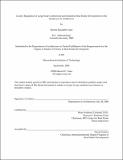Country regulation of large scale commercial and industrial real estate development in the southwest : is it effective?
Author(s)
Yates, Barrett Elizabeth
DownloadFull printable version (1.568Mb)
Other Contributors
Massachusetts Institute of Technology. Dept. of Architecture.
Advisor
Brian Anthony Ciochetti.
Terms of use
Metadata
Show full item recordAbstract
Real estate developers and county officials were surveyed to determine the existence, content and accessibility of county regulatory guidelines for land use and real estate development projects in the southwestern US. Further, the developers and county officials were interviewed to understand the relationship between the quality of the regulatory guidelines and the associated process, and the quality of real estate development in the specified counties. The results from the survey and interview processes were analyzed to assess the efficacy of the county regulatory process for large scale commercial and industrial real estate development. In most counties where the surveys were conducted, guidelines covering zoning and zoning related processes, planning, public works and transportation did exist but their currency and relevancy was questionable. All county regulatory bodies surveyed were in the process of updating the guidelines to make them current, clear and comprehensive for the existing communities, many of which were experiencing rapid population growth. County officials and developers agreed that quality of regulation significantly affects the quality of real estate development, thus impacting future economic development. (cont.) This thesis recommends updating guidelines to focus on certain key aspects for each guideline area studied: zoning and zoning related processes, planning, public works and transportation. Further, this thesis recommends bifurcating the guidelines and approval processes for large developments which can dramatically impact infrastructure, transportation and community sustainability versus small developments which may have a negligible impact on these areas. Additionally, this thesis contemplates the establishment of regional bodies to oversee certain aspects of land use planning unifying neighboring areas and reducing duplication of planning efforts in adjacent counties.
Description
Thesis (S.M.)--Massachusetts Institute of Technology, Dept. of Architecture, 2006. This electronic version was submitted by the student author. The certified thesis is available in the Institute Archives and Special Collections. Includes bibliographical references (leaf 45).
Date issued
2006Department
Massachusetts Institute of Technology. Department of ArchitecturePublisher
Massachusetts Institute of Technology
Keywords
Architecture.